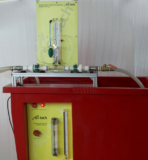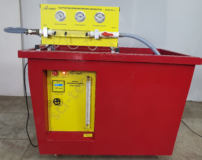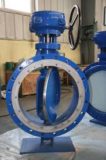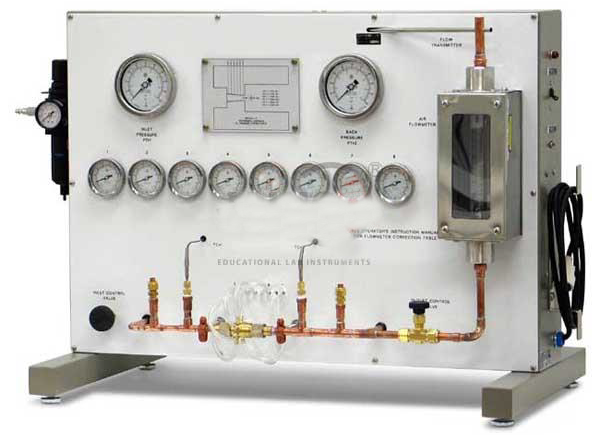Pressure Distribution Nozzles Performance Apparatus Model FM 51
Home » Products » Pressure Distribution Nozzles Performance Apparatus Model FM 51
Pressure Distribution Nozzles Performance Apparatus Model FM 51
Sci-tech Pressure Distribution Nozzle Performance Study Apparatus Model FM 51 is used to measure pressure curves in convergent and convergent-divergent nozzles (de Laval nozzles) and to study the actual flow of compressible fluids. In addition, the “choking effect” is demonstrated, where the mass flow rate stops increasing upon reaching the critical pressure ratio. Air is used as a compressible fluid.
In the experiment, the air flows through a nozzle and is thus accelerated. The pressure curve is recorded in the direction of flow over several measuring points. The air pressure upstream and downstream of the nozzle can be adjusted.
Three interchangeable nozzles are available to study the pressure and velocity ratios: one convergent contour and two de Laval nozzles with different length nozzle extensions.
The measured values for temperatures, pressures and mass flow rate are recorded.
The well-structured instructional material sets out the fundamentals and provides a step-by-step guide through the experiments.
Optional ‘Sci-Cal’ Computer Control Software & Interface in ‘LabVIEW’
| Size: | 80cm x 60cm x 60cm (LxWxH) |
| Weight: | 35 kg |
Item Description
Features
* Pressure distribution in convergent and divergent nozzles1
* Three nozzles with different contours1
* Speed of sound and shock wave
Convergent nozzles are used in the subsonic range. Velocities in the supersonic range can be achieved in de Laval nozzles; their nozzle geometry is a combination of convergent and divergent contours. De Laval nozzles are used in supersonic wind tunnels, steam turbines, jet engines and rocket technology. Pressure curves are a good way of representing the different velocity ranges in the nozzle, such as subsonic, supersonic and shock wave.
The experimental unit Sci-tech Pressure Distribution Nozzle Performance Study Apparatus Model FM 51 is used to measure pressure curves in convergent and convergent-divergent nozzles (de Laval nozzles) and to study the actual flow of compressible fluids. In addition, the “choking effect” is demonstrated, where the mass flow rate stops increasing upon reaching the critical pressure ratio. Air is used as a compressible fluid.
In the experiment, the air flows through a nozzle and is thus accelerated. The pressure curve is recorded in the direction of flow over several measuring points. The air pressure upstream and downstream of the nozzle can be adjusted.
Three interchangeable nozzles are available to study the pressure and velocity ratios: one convergent contour and two de Laval nozzles with different length nozzle extensions.
The measured values for temperatures, pressures and mass flow rate are recorded.
The well-structured instructional material sets out the fundamentals and provides a step-by-step guide through the experiments.
Optional ‘Sci-Cal’ Computer Control Software & Interface in ‘LabVIEW’
Technical Specifications
[1] Nozzle pressure distribution in actual flow of compressible fluids
[2] Three nozzles with pressure measurement points: 1 convergent nozzle, 1 short and 1 long de Laval nozzle
[3] Compressed air regulator for adjusting the pressure downstream of the nozzle
[4] Needle valve on the flow meter for adjusting the back pressure
[5] Instruments: manometer and digital temperature display upstream and downstream of the nozzle as well as rotameter
Technical Specifications
Air consumption of the experimental unit
– compressed air: max. 10bar
– air consumption: approx. 5g/s
3 nozzles, brass
– 1 x de Laval nozzle, short nozzle extension
– 1 x de Laval nozzle, long nozzle extension
– 1 x convergent nozzle
Compressed air regulator
– control range: 0…8,6bar
Measuring ranges
– temperature: 0…100°C
– pressure: 2x 0…10bar, 8x 1…9bar
– mass flow rate: 0,7…8,3g/s
‘Sci-Cal’ Computer Control Software & Interface in ‘LabVIEW’.
‘Sci-Cal’ software & hardware has been designed for use with more than 600 ‘Sci-tech’ trainers. ‘Sci-Cal’ comes in a module that can be fitted or mounted on the Sci-tech trainers very easily.
‘Sci-Cal’ box has 11 inches front HMI interactive panel, inside are i3 processor computer with it’s own hard drive & software processor with 16 to 32 analog and 16 to 32 digital signal data-loggers. The ‘LabVIEW’ processes the input signal with in-built data and formulae to tabulate results for the Sci-tech trainers.
‘Sci-Cal’ box has HDMI output for connection to a projector or an electronic whiteboard or a monitor.
‘Sci-Cal’ box has input ports for inputs from the Sci-tech trainer sensors.
‘Sci-Cal’ eliminates requirement of external computer.
Model Number
FM 51
See also different:

Sci-tech Pitot Static Tube Apparatus Model FM 52 is used to measure the local velocity at a given point in the flow stress. A pitot tube of standard design made of copper/SS is supplied and is fixed below Vernier scale. The Vernier scale is ca [...]

The Sci-tech Cavitation Demonstration Apparatus Model FM 19 is a compact bench top unit and has been designed to visualize and study the cavitation phenomenon in water flow. The apparatus consists of a venturi - shaped test section made of cle [...]

Sci-tech Butterfly Valve & Non-Return Valve Assembly Model FMSC-BVNR are used where flow reversal is not permitted. They must fully seal off the reverse direction while offering the lowest possible resistance in the forward flow direction. [...]

